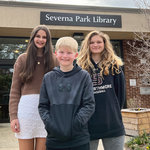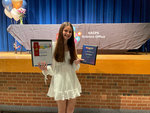Clear, 69°
Wind: mph,


Annapolis High School hosted the 2022 science and engineering awards and recognitions ceremony on March 8, showcasing nearly 90 outstanding student scientists and engineers recognized for their research in the Anne Arundel County Public Schools Science and Engineering Expo in February.
Winners were chosen after a stringent review process by 150 judges from professional and community organizations. The Severna Park Voice caught up with three students, including grand award winner Emily Ernst from Broadneck High School, Lily McCallister from Severna Park High School and Charles Larson from Magothy River Middle School.
Emily Ernst
Broadneck High School
Title: “The Power of Tides: The Relationship Between Tides and Enterococci”
“I have grown up in an area where water contamination is a constant concern,” said Emily, a junior. “I wanted to better understand the factors that influence when it’s safe to swim in coastal waters. I hope to continue this line of research in college. The study focused on water conditions at a coastal inlet in South Florida (Jupiter Inlet in Palm Beach County) where my grandmother lived and where I vacationed as a child.”
Emily hypothesized that enterococci contamination at coastal inlets will be greatest during periods of outgoing and low tides, and lowest during periods of incoming and high tides. And, during incoming tides, enterococci contamination at coastal inlets will decrease over time until reaching its lowest levels at high tide, and at outgoing tides, the enterococci contamination will increase over time, reaching its highest levels at low tide. Both hypotheses assumed incoming ocean water is less contaminated by runoff than water coming from inland sources.
The study found strong support for her first hypothesis, and partial support for hypothesis two.
“In the future, it would be interesting to study if the findings were replicable in other coastal areas, such as the Chesapeake Bay,” Emily said. “Additional research is needed to explore the dynamics of enterococci contamination at the end of tidal phases.”
As a grand award winner, Emily received an invitation to attend the 2022 International Science and Engineering Fair from May 7–13 in Atlanta.
“I like the idea of exploring the unknown, especially questions related to the environment that have human health impacts,” she added. “For me, science is just about asking why and seeing where the answers lead. It is a journey.”
Lily McCallister
Severna Park High School
Title: “Clearing the Air”
A freshman at Severna Park High School, Lily has been excelling in STEM activities since elementary school. Her latest project, “Clearing the Air,” tested air purifier filter styles to determine which one trapped more airborne particulate matter.
Lily said she came up with the idea to test different air purifiers due to the COVID pandemic when people were purchasing air purifiers to help stop the spread of the virus. The COVID pandemic got her curious whether a homemade purifier could perform better than a store-bought air purifier.
“If a homemade air purifier has four HEPA filters sucking air from four sides, it will filter air at a faster rate compared to the expensive store-bought Honeywell 300,” Lily reasoned. “The homemade air purifier will compete better at collecting more air particles because it has greater surface area.”
After her experiment, results proved that the homemade purifier covers more surface area because it drew air in from all four sides, while the Honeywell took in air only from the front.
“The homemade air purifier is more effective than the Honeywell air purifier in filtering,” she explained. “The homemade air purifier cleaned at a faster rate, significantly reduced the airborne particles levels, and is more cost effective. It is only effective at filtering out particulate matter, not the virus.”
Charles Larson
Magothy River Middle School
Title: “Tracking Lost Library Books”
“I built a GPS tracker using a Raspberry Pi and attached it to my book with an elastic headband,” said Charles, a sixth-grader at Magothy River Middle School. “The Raspberry Pi is a computer the size of a credit card. I coded it so that it would talk to the GPS tracker and an IoT [internet of things] dashboard. The IoT dashboard recorded the location of the book within about 150 feet. The device was attached to the book with a headband, so you won’t lose your book, or your page!”
For more information about STEM in AACPS, the annual Science and Engineering Expo, and a full list of this year’s winners, visit www.aacps.org/page/5727.
Comments
No comments on this item Please log in to comment by clicking here